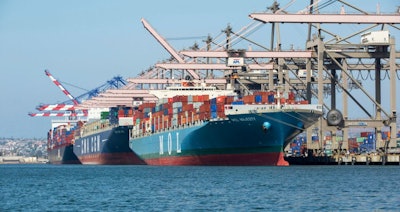
The nation's busiest port complex on Wednesday released a sweeping plan to eliminate air pollution from ships, trucks and cargo handling at a cost of up to $14 billion.
The draft of the updated 2017 Clean Air Action Plan calls for using emission-free electric cargo-handling equipment at the ports of Los Angeles and Long Beach by 2030 and replacing some 17,000 cargo-hauling diesel trucks with zero-emission alternatives by 2035.
The plan also would expand the use of trains to haul cargo from the ports and encourage the use of new technology to reduce smog from ships berthing there.
The adjoining Los Angeles and Long Beach ports represent the ninth-largest port complex in the world, handing about 40 percent of goods imported in containers and 25 percent of total exports.
Thanks to anti-smog efforts, the ports have seen dramatic reductions in some air pollution over the past decade but they are still the largest single source of air pollution in Southern California. The pollution is blamed for burdening harbor communities with increased asthma rates and the region's highest cancer risk from air pollution.
Last month, Los Angeles Mayor Eric Garcetti and Long Beach Mayor Robert Garcia jointly pledged to move toward making the ports emission-free.
The public has until Sept. 18 to comment on the latest proposal. The Los Angeles and Long Beach harbor commissions are expected to vote on the plan in November.
"These ports are going where no port has gone before," Port of Los Angeles Executive Director Gene Seroka said in a statement. "Based on what we've already accomplished to promote healthy, robust trade through our gateway, we're ready to make history again, looking at a new array of technologies and strategies to further lower port-related emissions in the decades ahead."
The plan sets goals of reducing greenhouse gas emissions 40 percent below 1990 levels by 2030 and 80 percent below 1990 levels by 2050.
However, it won't be cheap. A preliminary analysis estimates the implementation cost at $7 billion to $14 billion, with most of the additional costs involving replacing diesel trucks with zero-emission options such as electric power or natural gas.
The plan suggests that funding will be provided by the ports, state and federal governments and private industry.
A trade group for shippers was skeptical of the plan, voicing concerns that it will bump up costs at a time when there is increasing competition among seaports.
The "stringent" proposals "will yield small emissions gains but do so at enormous costs to shippers and in turn, a long list of supply chain members which are critical to the region's economy," John McLaurin, president of the Pacific Merchant Shipping Association, said in a statement.
The updated version "puts all its eggs in one basket by unrealistically assuming that non-existent, non-automated, zero-emissions electric cargo handling equipment technology will be developed, tested, work as planned and be affordably mass produced to meet the ports' rigid timelines," he said.





















